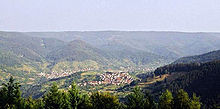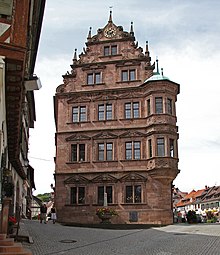Marchship
The Murgschifferschaft is since the late Middle Ages existing timber trading company in the Black Forest, on a cooperative basis. It is based in Forbach (originally in Gernsbach ) and manages forests in the catchment area of the upper Murg . The first order it has been handed down comes from the year 1488. The part of the name Schiffer refers to what was once the most important form of transport for wood, rafting .
history

Since at least the 13th century, the timber trade has been one of the sources of income for the residents of Gernsbach and the villages in the Murg Valley, alongside viticulture and cattle breeding. Trees were felled, sawn and Murg and down the Rhine floated . At the beginning of the 15th century, the timber trade was expanded, which led to the rights and obligations of those involved being contractually regulated in 1488. The "Ordinance of the common wood trade in Murgentall" dating from this year contains 41 articles with almost 400 individual points and is considered the birth certificate of the Murgschifferschaft. Once a year, the Murgschiffer gathered to "reprimand", where they decided on disputes, punished violators of the order and their leadership, the four "main sailors" elected.
While the Murg boatmen were enfeoffed with forest usage rights by their sovereigns, the Counts of Eberstein and the Margraves of Baden , towards the end of the 15th century they began to acquire their own property. In 1569, Philip II of Eberstein sold his sawmills and forests to the Murgschifferschaft in order to be able to settle his debts. Even Philip II. Of Baden-Baden selling the Murgschifferschaft large forest areas to the reconstruction of the new castle in Baden-Baden to finance.
Due to the endeavors of the authorities to expand their influence on economic life, from the middle of the 16th century the marshallership was no longer represented by four, but only by a single main skipper. Jakob Kast held this position from 1587 until his death in 1615 . He exercised a state trade monopoly for decades and shared half of the net profit with the margraves. He rafted as far as Holland. The proceeds from this business made him very rich. His contemporaries accused him of exploiting the other mudsliders. He increased his fortune through credit transactions, leaving behind about 500,000 guilders . His eldest son Johann Jakob Kast had the old town hall built in Gernsbach, his second oldest son Philip Kast succeeded Jacob as the main skipper. During his tenure in office, the Murgschiffer decided in 1626 a new rules for boatmen, which among other things brought wage increases for the forest workers. The Thirty Years' War and subsequent wars resulted in a long-lasting decline, also for the Murg Valley timber trade, which only ended in the middle of the 18th century. In the export of large quantities of long wood to Holland, which began in the second half of the 18th century, the mudships had no share, this was carried out by more financially strong foreign companies. With their sawmills, the Murgschifferschaft specialized in processed firewood and boards, which, with the increase in population along the Rhine, also found more demand.
The haphazard deforestation and unrestricted forest pasture until the beginning of the 19th century led to the clearing of large areas of land. In 1814 only a quarter of the Schifferwald was overgrown with usable trees. Until 1833, the areas were replanted with spruce, fir and pine on the basis of the Baden forestry laws, which required sustainability.
Among other things, through the modernization of the sawmills and the conversion into wood and paper mills, the members of the Murgschifferschaft, especially their chairman of the board of directors, the Reichstag deputy Casimir Rudolf Katz , were also significantly involved in the industrialization of the Murg Valley. The skippers supported the establishment of the Gernsbach district savings bank in 1857 and paid interest on the deposits. The treasurer and chairman of the board of directors were Murgschiffer, the Sparkasse opened in the office of the Murgschifferschaft. The Murgschifferschaft was partner of "Murgthal Railway Company," which opened in 1869 to build the first section of the Murgtalbahn of Rastatt funded to Gernsbach. By the beginning of the 20th century, the railroad gradually replaced rafting on the Murg. At the end of the 19th century, the Murgschifferschaft rearranged their internal circumstances and divided the common property into 100,000 alienable forest rights. The Baden state gradually bought shares in the following decades and became the majority owner.
The maritime shipship today

organization
The statutory goal of the Murgschifferschaft is to achieve “the highest possible sustainable yield of valuable wood and profit” . The profit is distributed annually to the members of the cooperative in accordance with their shares. The shares are 100,000 "forest rights", which are distributed among around 120 members of the cooperative. The largest shareholder is the state of Baden-Württemberg with around 55,000 forest rights . The legal representation is incumbent on the board of directors, which is composed of the three highest participating members and two elected members.
Legal status
The Murgschifferschaft has the legal status of an old law cooperative under private law. The forest of the Murgschifferschaft ("Schifferwald") has the legal status of a private forest as a community forest in accordance with Section 56 (1) of the State Forest Act for Baden-Württemberg .
Economic indicators
The Schifferwald has an area of approx. 5450 hectares. The state of Baden-Württemberg values the share capital of the Murgschifferschaft at around 53 million euros. The number of permanent employees fell from 59 to six between 1979 and 2007.
literature
- Max Scheifele , Casimir Katz , Eckart Wolf: The Murgschifferschaft. History of the raft trade, the forest and the timber industry in the Murg Valley . Series of publications by the State Forest Administration of Baden-Württemberg (Volume 66). 2nd Edition. Katz, Gernsbach 1995, 521 pages, ISBN 3-925825-20-7
Web links
supporting documents
Individual evidence
- ^ Scheifele: Murgschifferschaft , page 183
- ↑ Casimir Katz : The Murgschifferschaft and the wood and paper industry. In: Scheifele: Murgschifferschaft , page 497.
- ↑ Manfred Fieting: Gernsbach and its neighborhoods. Sutton, Erfurt 2011, ISBN 978-3-86680-814-0 , p. 32.
swell
- Murgschifferschaft - management of a large forest cooperative - forest history (documents for an excursion as part of the conference of the German Forest Association 2007 in Baden-Baden. Internet offer no longer available)
- Assets overview of the state of Baden-Württemberg as of January 1, 2006 (PDF; 112 kB)
- Landtag printed matter 12/5919 (PDF file; 11 kB)
- Forbach community forest
- Manuela Dessau: Gernsbach and its old town hall. Elster-Verlag, Bühl-Moos 1984, ISBN 3-89151-002-0 .
